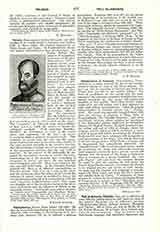

Telesphorus of Cosenza (THEOPHORUS, THEOLOPHORUS), a name assumed by one of the pseudo-prophets during the time of the Great Schism. He gave out that he was born at Cosenza and lived as a hermit near the site of the ancient Thebes. His book of predictions on the schism was the most popular of the numerous prophetic treatises that were spread broadcast by the many self-constituted prophets of that period. More than twenty manuscripts of it are still extant, and it first appeared in print with various interpolations: “Liber de magnis tribulationibus in proximo futuris, etc.” (Venice, 1516). The work was originally compiled about 1386 from the writings of Joachim of Flora, John of Roquetaillande, the “Cyrillic Prophecy“, and other apocalyptic treatises whose authors are mentioned in the dedicatory preface addressed to Antoniotto Adorno, the Doge of Venice. Its chief prophecies are: the schism will end in 1393 at Perugia, where the antipope and his followers will be punished; a short period of peace will follow, whereupon the Emperor Frederick III with three antipopes will inaugurate a cruel persecution of the clergy, who will be deprived of all their temporalities; King Charles of France will be imprisoned, but miraculously liberated; the “Angelic Pastor” will ascend the papal throne; under his pontificate the clergy will voluntarily renounce their temporal possessions and a general council will legislate that the income of the clergy is limited to what is necessary for a decent livelihood; the “Angelic Pastor” will take from the German electors the right to elect the emperor, he will crown the French King Charles emperor, and restore the Church to its original poverty and service of God; finally, the pope and the emperor will undertake a crusade, regain the Holy Land, and bring the Jews, Greeks, and infidels back to Christ. A refutation of these prophecies, written by the German theologian Henry of Langenstein, is printed in Pez, “Thesaurus Anecdotorum Noviss,” I II (Augsburg, 1721-9), 507-64.
MICHAEL OTT

